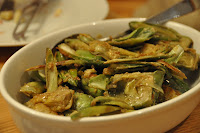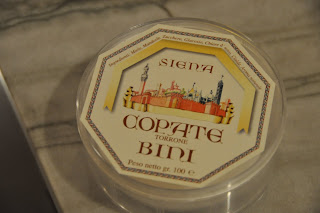6 small/baby artichokes -- wash and prepare them, ie remove the outer smaller leaves at the base of each artichoke and then slice each into 3 wedges. Dredge them in flour and then dip in beaten egg yolks. Now fry gently in 3 to 4 tablespoons of unsalted butter (over a medium heat) until the artichokes are tender and browned. Salt to taste. Serve with lots of melted butter.
Serve alongside a plate of charcuterie (wild boar salami, prosciutto, etc) with olives.
Adding a cheese platter doesn't hurt too much either
We brought back several Italian treats -- both to die for and they won't last long
This is a torrone (nougat) wrapped in rice paper. Chewy, sweet, delicious
Panforte is dense sweet cake with orange and lemon rind to name just a few of its many ingredients...
from Wikipedia:
Documents from 1205 show that panforte was paid to the monks and nuns of a local monastery as a tax or tithe which was due on the seventh of February that year. Literally, panforte means "strong bread" which refers to the spicy flavour. The original name of panforte was "panpepato" (peppered bread), due to the strong pepper used in the cake. There are references to the Crusaders carrying panforte, a durable confection, with them on their quests, and to the use of panforte in surviving sieges.
The process of making is fairly simple. Sugar is dissolved in honey and various nuts, fruits and spices are mixed together with flour. The entire mixture is baked in a shallow pan.
Currently there are many shops in Italy producing panforte, each recipe being their jealously guarded interpretation of the original confection and packaged in distinctive wrapping. Usually a small wedge is served with coffee or a dessert wine after a meal, though some enjoy it with their coffee at breakfast.
In Siena — which is regarded by many, not least most inhabitants of that city, as the panforte capital of Italy — it is sometimes said that panforte should properly contain seventeen different ingredients, seventeen being the number of Contrade within the city walls.











